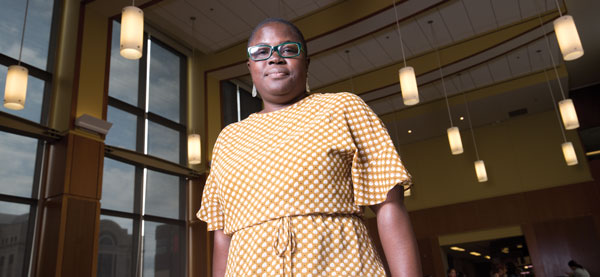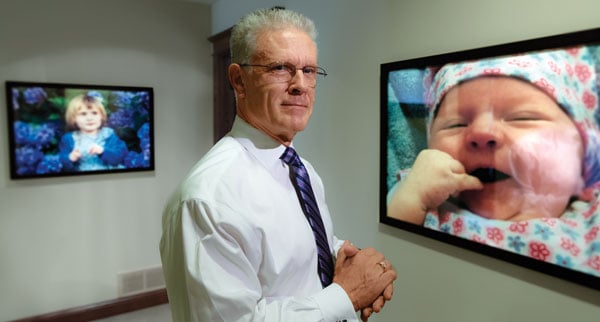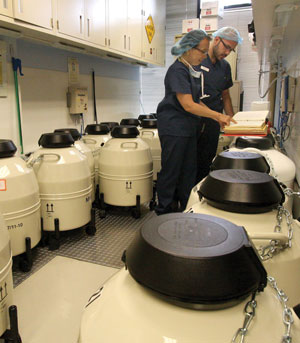Contentious battles between couples over frozen embryos raise legal and ethical dilemmas

Illustration by Stephen Webster
They discovered their best hope for creating a baby was through in vitro fertilization. IVF is a series of procedures involving extracting eggs from a woman’s body, combining them with sperm in a laboratory and then placing them inside her uterus. Fertility doctors can also cryopreserve any excess embryos so they can be thawed and used later.
Levine and her husband, who worked in real estate finance, had four frozen embryos. The couple went through more than 10 IVF cycles, but they split up before they were able to have a baby. At the time of their separation, Levine was in her mid-40s.
During the divorce process, Levine and her ex battled over custody of the embryos because, while she still wanted to be a parent, he no longer did. He wanted the embryos destroyed, and she wanted to keep them frozen so she could, possibly, have a baby in the future.
The couple had signed a consent form with the clinic that did not address what would happen to their frozen embryos should they divorce. Levine believes her ex-husband, who has since passed away, was concerned that should he allow her to keep the embryos, he could be forced to pay child support.
Levine says that her ex was gearing up for a big legal battle, and that she was told she couldn’t afford to fight him. She agreed to give up the embryos, and they were destroyed.
“I wanted them,” says Levine, now 53. “I still think about them. It doesn’t go away. I wish I had them.”
Couples going through IVF often discuss and agree upon what to do with their frozen embryos. In addition, fertility clinics’ paperwork often includes an agreement regarding frozen embryo use.
But when a couple no longer want to stay together, any mutual understanding they thought they had over frozen embryos can go by the wayside. In a small number of cases, a divorcing couple’s battle over frozen embryos escalates into a contentious custody dispute. Their personal and emotional battles can garner national and even international attention.

Risa Levine. Photograph by Arnie Adler.
Levine and her ex-husband’s struggle over who got custody of the frozen embryos didn’t end up in a protracted legal battle. But it does highlight a legal and ethical debate: Whose rights should prevail under the circumstances—the person who wants to procreate or the person who does not? Or should judges recognize the rights of the embryos as unborn children and make decisions about their future as they would in any other custody case?
LIFE OR PROPERTY?
It has been nearly 40 years since Louise Joy Brown, the world’s first IVF baby, was conceived. Since then, the number of people attempting IVF and other assisted reproductive technologies has multiplied, as the methods have grown increasingly successful. In 2013 babies conceived through IVF accounted for more than 1.5 percent of total U.S. births, according to the Society for Assisted Reproductive Technology.
There are more than 600,000 cryopreserved embryos in the nation, according to the U.S. Department of Health and Human Services.
“What is an embryo? Is it life; is it property; is it both? Is it something in between?” says Kimberly Mutcherson, vice dean and professor of law at Rutgers Law School. Mutcherson, who teaches courses on health law policy, bioethics, torts and family law, has written scholarly articles on assisted reproduction.
Battles over frozen embryos ask “big existential questions about the nature of life,” she says. “Any discussion about embryos gets us close to the abortion debate, which means legislatures are reluctant to get involved. But it’s a question we need to address: What is an embryo?”

Kimberly Mutcherson. Photograph by Arnie Adler.
While the cases ask big questions, they are also relatively rare, Mutcherson says.
“There are really only a small percentage of folks who will find themselves in relationships that fracture and with frozen embryos in storage and who can’t agree on what to do about them,” she says.
The majority of state legislatures have yet to tackle the delicate questions presented by advances in fertility treatments, says Steven H. Snyder, head of a small firm specializing in fertility law in Maple Grove, Minnesota. Snyder says that state legislatures likely are reluctant to jump into the topic because embryo disposition is still a relatively new family law issue and tends to be overlooked in the larger battles over assisted reproduction.
In general, couples go into their fertility treatments assuming they will stay together. But, Snyder says, couples signing consent forms that address potential divorce and embryo distribution don’t know whether that agreement will be honored or ignored.
“As long as we don’t have legislation in place, the courts are going to be all over the map,” says Snyder, former chair of the ABA Section of Family Law’s Assisted Reproductive Technologies Committee. “We need to get family law aligned with assisted reproductive technology.”
In the debate over frozen embryos, language becomes important. The term embryo is a general one used to describe the combination of sperm and egg, though it’s given other names. They may be called zygotes (the early combination of an egg and sperm), pre-embryos (a fertilized ovum before implantation) or simply embryos (generally post-implantation). Embryos are generally frozen one, three or five days after sperm and egg have been combined.
The Thomas More Society, a conservative, not-for-profit law firm representing the National Catholic Bioethics Center and the American Association of Pro-Life Obstetricians and Gynecologists, asserts that human life begins at fertilization. Embryos, the society argues in court filings, should be treated as human beings in custody disputes.

FROZEN FUTURES: Fertility doctors can preserve extra embryos created during in vitro fertilization through cryopreservation, or freezing. No federal law, and few state laws, address the question of the division of frozen embryos during a divorce. So far, at least 10 state courts have handled such disputes. AP Photo.
Thus far, courts have tended to view embryos as property or something in between, but not as human beings, says Thomas Olp, an attorney in Aurora, Illinois, and Thomas More Society board member who has worked on its cases.
“Embryos, even at their earliest stage, are not chattel or property; they are human beings,” he says. “They are deserving of respect and dignity. In a custody dispute, the right to life should be respected.”
There’s no federal law, and few state laws, addressing the question of the division of frozen embryos during a divorce. Family law judges have had to wing it, with predictably differing approaches. So far, at least 10 state courts have addressed disputes over custody and the future of frozen embryos, with varying legal theories and results.
Most courts have found that frozen embryos are quasi-property and therefore look first to written contracts addressing disbursement.
“It’s been pretty much left up to the judges to make these determinations,” says Arthur Caplan, head of the Division of Bioethics at New York University’s Langone Medical Center in New York City. “Judges try using common law, but their values leak in. … How the embryos will be treated can depend upon the whim of the judge—and the luck of the draw. When it comes to making human lives, you would expect a society to have more consistent laws they follow.”
But, Caplan points out, if judges or legislators define embryos as life for custody disputes, there would be far-reaching ramifications.
“If embryos are treated as potential people, it is then in their best interests to become full-fledged adults,” says Caplan. “Therefore, it becomes difficult to dispose of the embryos or donate them to science.”
POTENTIAL FOR LIFE
The first case to address custody of frozen embryos concerned a Tennessee couple that had no written contract with a Knoxville fertility clinic or each other about what should happen to the embryos were they to divorce.
According to the case history, Junior Lewis Davis wanted the frozen embryos he made with former wife Mary Sue Davis destroyed. She originally wanted the embryos to attempt to have a child herself. Later, she wanted to donate the remaining embryos to a childless couple.
A Tennessee trial court had found that the embryos were essentially children, so awarded custody to Mary Sue Davis. The Tennessee Court of Appeals reversed.
Ruling on Davis v. Davis in 1992, the Tennessee Supreme Court noted the U.S. Supreme Court’s decisions in Roe v. Wade and Webster v. Reproductive Health Services, discussing the right to procreational autonomy.
The court said that embryos are neither people nor property, but “occupy an interim category that entitles them to special respect because of their potential for human life.”
The Tennessee Supreme Court then determined that there was both a right to procreate and a right to privacy—or not to procreate. The court then concluded that the appropriate test balances the competing interests of the parties.
The court concluded that Mary Sue Davis’ interest in donating the embryos was not as significant as her ex-husband’s interest in avoiding parenthood.
“If she were allowed to donate these pre-embryos, he would face a lifetime of either wondering about his parental status or knowing about his parental status but having no control over it,” the court stated.
The court stated that, generally, “the party wishing to avoid procreation should prevail, assuming that the other party has a reasonable possibility of achieving parenthood by means other than use of the pre-embyros in question.”
CONSENT AGREEMENTS
In the years after Davis v. Davis, courts have tended to look for a consent agreement between the couple and the fertility clinic. Some courts have chosen to follow the terms of the agreement.
In Kass v. Kass, for example, a divorcing couple’s battle over embryos landed in the New York court system. The couple had agreed in writing to donate unused embryos to research in the event of death or other unforeseen circumstances. But during the divorce process, the wife argued for custody of the embryos instead. The consent forms did not specify what the couple would do if they divorced.
The New York Court of Appeals found in 1998 that consent forms between a fertility clinic and a couple should be upheld. Courts in Oregon, Texas and Washington state have thus far followed the terms of a consent agreement.
Last year a California judge ordered frozen embryos a woman wanted to use over her ex-husband’s objections “thawed and discarded.” In November, San Francisco Superior Court Judge Anne-Christine Massullo issued an 83-page decision upholding the consent form provided to the couple by the fertility clinic.
Dr. Mimi Lee, an anesthesiologist and musician in her mid-40s, has argued that, despite the agreement, she wanted the embryos because her age would preclude her from having a biological child. Lee and her former husband, Stephen Findley, an investment executive, had created the embryos before she underwent treatment for breast cancer.
Lee argued that she viewed the consent agreement as more of a directive than a contract. But Massullo found her testimony unconvincing.
“Given Lee’s education, profession and intelligence, the court finds that her testimony that she did not intend to enter into a binding agreement was not credible,” the judge wrote.
But courts haven’t uniformly followed consent agreements. For example, the Massachusetts Supreme Judicial Court said in 2000 that it wouldn’t enforce consent forms in which the couple has previously agreed to give any embryos to the ex-wife, when and if the ex-husband no longer wanted to be a father.
The court said, in part, that the consent form was not a “separation agreement that is binding on the couple in a divorce proceeding.”
It also stated that “even had the husband and wife entered into an unambiguous agreement between themselves regarding the disposition of the frozen pre-embryos, we would not enforce an agreement that would compel one donor to become a parent against his or her will.
“As a matter of public policy, we conclude that forced procreation is not an area amenable to judicial enforcement.”
LAST CHANCE DOCTRINE
In the San Francisco case, Lee, 46 at the time, argued that the embryos represented her last chance of having a biological child.
In general, women’s fertility, meaning egg quality and quantity, declines with age. A doctor testifying for the fertility clinic stated that a 46-year-old woman has a 0 to 5 percent chance of having a child with her own eggs. Another doctor testified that Lee had a 0.03 percent chance of conceiving using her own eggs.
Nevertheless, Massullo ruled against Lee. Massullo said the evidence showed that Lee “was ambivalent about having a child both during and after her breakup with Findley.”
Other courts, however, have ruled in favor of women who would, without the embryos, likely never have biological children. Mutcherson says there has been “a tiny carve-out for an exception,” in which a few courts found “if this was the person’s last chance of parenthood, then they should get the embryos.”
In 2012, for example, a Pennsylvania Superior Court judge examined a case involving a divorcing couple in which the wife had been diagnosed with breast cancer. The court found that the woman’s sole opportunity to achieve biological parenthood rested with the embryos, and therefore the balancing of interests tipped in her favor.
And last year, an Illinois appellate court held 2-to-1 that Dr. Karla Dunston, a woman diagnosed with lymphoma, should get custody of frozen embryos she made with ex-boyfriend Jacob Szafranski.
To Dunston, the embryos also represent her last chance at having a biological child. Szafranski, however, says that he has a constitutional protection against forced procreation. The couple made the embryos after Dunston’s diagnosis, before she began chemotherapy. Dunston is now in remission.
The couple had made an oral contract and also signed an informed consent form with the fertility clinic. The oral contract is said to have been a quick phone call in which Dunston told Szafranski that she had been diagnosed with lymphoma and Szafranski agreed to help her preserve her ability to have a baby.
The panel concurred that the embryos represented Dunston’s last opportunity to have a biological child with her own eggs, and that Szafranski had agreed to help her.
In March, the U.S. Supreme Court denied Szafranski’s petition to hear the case.

Steven Snyder. Photograph by Wayne Slezak.
DIVORCE AND THE DEBATE
Anti-abortion activists have recently joined the debate over what should happen to frozen embryos during a contested divorce. The Thomas More Society argues that courts should pursue the best interests of the embryos, as they would in a child custody battle.
In two recent custody battles—one in Missouri and the other in California—the group has filed amicus briefs to argue that the embryos are human lives and should be treated as such. A Missouri legislator has also introduced a bill that would define frozen embryos as human life. The media have focused on the California case because it involves the frozen embryos of Modern Family star Sofía Vergara and her ex-fiancé, Nick Loeb.
In Loeb v. Vergara, Loeb has been fighting for custody of the embryos so he can bring them to life using a gestational carrier. Vergara wants the embryos to remain in frozen storage. The couple had a contract with the fertility clinic that they both signed. The contract states the embryos can be brought to term only if both parties consent.
Loeb says he wants the contract voided and to take custody of the embryos, so that he can try to have them implanted in a surrogate.
“Many have asked me: Why not just move on and have a family of your own? I have every intention of doing so,” Loeb wrote in a New York Times op-ed. “But that doesn’t mean I should let the two lives I have already created be destroyed or sit in a freezer until the end of time.”
In its amicus brief, the Thomas More Society said that a “review of current relevant science establishes that the embryos are human beings at fertilization and may not be treated—as some courts have done—as property, or as less than fully human and without rights to parental or governmental protection.”
Anti-abortion activists, Mutcherson says, are using the issue of frozen embryos as a “backdoor way to get at abortion by intervening in these incredibly private disputes.”
“Abortion politics have always been a part of assisted reproduction, but these cases lay that bare,” she says.
PRACTICAL CONCERNS
States, Caplan says, need to address the ambiguity in the law: Should an embryo be considered a person in divorces? Should an embryo be considered property or something in between? Legislation, Caplan says, should explicitly address whether individuals with frozen embryos should be able to become parents against their will and, if so, under what circumstances. The legislation should also address whether an individual who does not want to become a parent can be forced to financially support the child.
“Yes, legislators don’t want to address these issues because it gets them too close to the abortion debate,” says Caplan. “But, with an eye towards the future, towards cloning, towards a time when you can make children from the cell of a person, it’s important to get the laws straightened away.”
In the absence of settled law or clear legislation, practitioners advise their clients that informed consent agreements with fertility clinics, while useful, aren’t necessarily considered binding. Nevertheless, practitioners and individuals who have been through the fertility process suggest that fertility clinics specify in their documents what happens to embryos during divorce.
“Should the medical consent forms signed by the parties be viewed as a contract to be honored? Or should they be viewed as merely advanced directives, which can be revised or revoked at any time?” asks Richard Vaughn, chair of the ABA Section of Family Law’s Assisted Reproductive Technologies Committee and a co-founder of the International Fertility Law Group in Los Angeles.
“If we don’t follow the signed agreements, are we creating a system with very little predictability?”
Denise Seidelman, a Bronxville, New York-based lawyer who specializes in adoption and assisted reproduction law, says individuals signing fertility clinic dispositional agreements aren’t paying enough attention to what they are signing.
“They act like they are signing a telephone contract, but they should really talk to a lawyer before signing any agreement relating to the disposition of their embryos. If there is ever a document to pay attention to, it’s one that controls your ability to use your embryos in the future,” Seidelman says.
Indeed, Vaughn suggests individuals using fertility treatments should consider signing a more formal document, a pre-embryo agreement, with lawyers present. Levine warns individuals going through fertility treatments to do what she did not—think ahead about what will happen to the embryos during a divorce proceeding.
“When you are both trying to have a baby, it never occurs to you that there will be a problem with your marriage,” Levine says. “But you should address divorce.”
However, Susan Crockin, a lawyer who specializes in reproductive technology law and teaches the subject at Georgetown University Law Center, doubts that many couples pursuing fertility treatments will bother with a formal contract spelling out what happens if they divorce.

Liquid nitrogen tanks utilized for storing embryos surround Nancy Huen, the in vitro fertilization lab supervisor, and embryologist Salu Ribeiro as they check storage records at the Reproductive Science Center in San Ramon, California. Used with Permission of San Jose Mercury News.
“The problem is that happily married couples come into treatment expecting their union to last forever,” says Crockin, who is also a faculty member in residence at Georgetown’s Kennedy Institute of Ethics. “I don’t see many of them wanting to hire lawyers or sign an agreement like that.”
Most couples with frozen embryos going through divorce avoid court battles by agreeing on what to do with their embryos at some point during the process.
“The good news is it’s not as if the courts are being clogged up with cases of people fighting over frozen embryos,” Mutcherson says. “This is really intimate stuff, and people tend to work it out so they don’t end up in court over it.”
SETTLEMENT ATTEMPTS
However, some fertility lawyers ask, what are the internal and external pressures that might lead an individual who wants custody of the embryos to give up fighting for them and settle instead?
In lawyer Levine’s case, she was told she couldn’t afford to fight for the embryos. Levine, who wound up not having children, believes that had her ex-husband not worried about paying child support, he might have been more inclined to allow her to use the embryos.
As Snyder explains, there are cases where “a couple would otherwise agree to allow one party to use the embryo, so long as the other party is not considered a parent.”
But, he adds, “in virtually every state, such agreements are not recommended since they are not necessarily enforceable.”
The New York legislature is considering a bill that would, among other things, allow a divorcing couple to give permission for one party to use the embryos, while the other party wouldn’t be considered a parent for legal purposes. Under the proposed law, the individual using the embryos could not then force the individual giving up parental rights to pay child support.
“People don’t create embryos on a whim,” says Levine. “The intent of the parties when creating an embryo is to make a baby, so when one person changes his mind, the other person may still want to be a parent. It seems grossly unfair to deprive a person who still wants to be a parent the ability to do so.”
This article originally appeared in the June 2016 issue of the ABA Journal with this headline: “Deep Freeze: Contentious battles between couples over preserved embryos raise legal and ethical dilemmas.”
Anna Stolley Persky is a freelance writer based in Washington, D.C.
Write a letter to the editor, share a story tip or update, or report an error.


